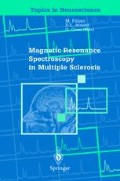Abstract
Multiple sclerosis (MS) is characterised pathologically by inflammatory focal demyelination at multiple sites in the central nervous system that recur over time. Clinically it is associated with recurrent attacks from which patients show good recovery in the early stages of the illness, usually followed by a chronic phase of progressive functional deterioration. Recent studies have postulated that the mechanism of injury in multiple sclerosis leading to chronic disability is axonal damage rather than the demyelination itself [1]. As has been shown in patients with focal ischaemic disease [2–5] or brain tumours [6], the axonal injury of MS may be expected to be associated with cortical reorganisation.
Access this chapter
Tax calculation will be finalised at checkout
Purchases are for personal use only
Preview
Unable to display preview. Download preview PDF.
References
Matthews PM, De Stefano N, Narayanan S et al (1998) Putting magnetic resonance0 spectroscopy studies in context: axonal damage and disability in multiple sclerosis. Semin Neurol 18: 327–336
Chollet F, Weiller C (1994) Imaging recovery of function following brain injury. Curr Opin Neurobiol 4: 226–230
Cao Y, D’Olhaberriague L, Vikingstad EM et al (1998) Pilot study of functional MRI to assess cerebral activation of motor function after poststroke hemiparesis. Stroke 29: 112–122
Cramer SC, Nelles G, Benson RR et al (1997) A functional MRI study of subjects recovered from hemiparetic stroke. Stroke 28: 2518–2527
Weiller C, Ramsay SC, Wise RJ et al (1993) Individual patterns of functional reorganization in the human cerebral cortex after capsular infarction. Ann Neurol 33: 181–189
Seitz RJ, Huang Y, Knorr U et al (1995) Large-scale plasticity of the human motor cortex. Neuroreport 6: 742–744
De Stefano N, Matthews PM, Arnold DL (1995) Reversible decreases in N-acetylaspartate after acute brain injury. Magn Reson Med 34: 721–727
Matthews PM, Clare S, Adcock J (1999) Functional magnetic resonance imaging: clinical applications and potential. J Inherit Metab Dis 22:337–352
Ogawa S, Lee TM, Kay AR, Tank DW (1990) Brain magnetic resonance imaging with contrast dependent on blood oxygenation. Proc Natl Acad Sci USA 87: 9868–9872
Buckner RL, Bandettini PA, O’Craven KM et al (1996) Detection of cortical activation0 during averaged single trials of a cognitive task using functional magnetic resonance imaging. Proc Natl Acad Sci USA 93: 14878–14883
Rosen BR, Buckner RL, Dale AM (1998) Event-related functional MRI: past, present, and future. Proc Natl Acad Sci USA 95: 773–780
Kim SG, Ashe J, Georgopoulos AP et al (1993) Functional imaging of human motor cortex at high magnetic field. J Neurophysiol 69: 297–302
Ploghaus A, Tracey I, Gati JS et al (1999) Dissociating pain from its anticipation in the human brain. Science 284: 1979–1981
Benson RR, FitzGerald DB, LeSueur LL et al (1999) Language dominance determined by whole brain functional MRI in patients with brain lesions. Neurology 52: 798–809
Talairach J, Tournoux P (1988) Coplanar stereotactic atlas of the human brain: 3-dimensional system, an approach to cerebral imaging. Thieme, Stuttgart
Friston KJ, Fletcher P, Josephs O et al (1998) Event-related fMRI: characterizing differential responses. Neuroimage 7: 30–40
Poline JB, Worsley KJ, Evans AC, Friston KJ (1997) Combining spatial extent and peak intensity to test for activations in functional imaging. Neuroimage 5: 83–96
Friston KJ, Josephs O, Rees G, Turner R (1998) Nonlinear event-related responses in fMRI. Magn Reson Med 39: 41–52
Cohen MS, DuBois RM (1999) Stability repeatability, and the expression of signal magnitude in functional magnetic resonance imaging. J Magn Reson Imaging 10: 33–40
Blinkenberg M, Jensen CV, Holm S et al (1999) A longitudinal study of cerebral glucose metabolism, MRI, and disability in patients with MS. Neurology 53: 149–153
Sun X, Tanaka M, Kondo S et al (1998) Clinical significance of reduced cerebral metabolism in multiple sclerosis: a combined PET and MRI study. Ann Nucl Med 12: 89–94
Roelcke U, Kappos L, Lechner-Scott J et al (1997) Reduced glucose metabolism in the frontal cortex and basal ganglia of multiple sclerosis patients with fatigue: a 18F-fluorodeoxyglucose positron emission tomography study. Neurology 48: 1566–1571
Simmons ML, Frondoza CG, Coyle JT (1991) Immunocytochemical localization of Nacetyl-aspartate with monoclonal antibodies. Neuroscience 45: 37–45
DeStefano N, Matthews PM, Fu L et al (1998) Axonal damage correlates with disability in patients with relapsing remitting multiple sclerosis: results of a longitudinal MR spectroscopy study. Brain 121: 1469–1477
Fu L, Matthews PM, De Stefano N et al (1998) Imaging axonal damage of normalappearing white matter in multiple sclerosis. Brain 121: 103–113
Reddy H, Narayanan S, Matthews PM et al (2000) Relating axonal injury to functional recovery in MS. Neurology 54: 236–239
Yousry TA, Berry I, Filippi M (1998) Functional magnetic resonance imaging in multiple sclerosis. J Neurol Neurosurg Psychiatry 64 (Suppl 1):S85–S87
Seil FJ (1997) Recovery and repair issues after stroke from the scientific perspective. Curr Opin Neurol 10: 49–51
Lee M, Reddy H, Johansen-Berg H et al (2000) The motor cortex shows adaptive functional changes to brain injury from multiple sclerosis. Ann Neurol 47: 606–613
Werring DJ, Bullmore ET, Toosy AT et al (2000) Recovery from optic neuritis is associated with a change in the distribution of cerebral response to visual stimulation: a functional magnetic resonance imaging study. J Neurol Neurosurg Psychiatry 68:441–449
Wexler BE, Fulbright RK, Lacadie CM et al (1997) An fMRI study of the human cortical motor system response to increasing functional demands. Magn Reson Imaging 15: 385–396
Editor information
Editors and Affiliations
Rights and permissions
Copyright information
© 2001 Springer-Verlag Italia
About this chapter
Cite this chapter
Reddy, H., Arnold, D.L., Matthews, P.M. (2001). Functional Magnetic Resonance Imaging and Multiple Sclerosis: Cortical Reorganisation and Recovery. In: Filippi, M., Arnold, D.L., Comi, G. (eds) Magnetic Resonance Spectroscopy in Multiple Sclerosis. Topics in Neuroscience. Springer, Milano. https://doi.org/10.1007/978-88-470-2109-9_7
Download citation
DOI: https://doi.org/10.1007/978-88-470-2109-9_7
Publisher Name: Springer, Milano
Print ISBN: 978-88-470-2164-8
Online ISBN: 978-88-470-2109-9
eBook Packages: Springer Book Archive

